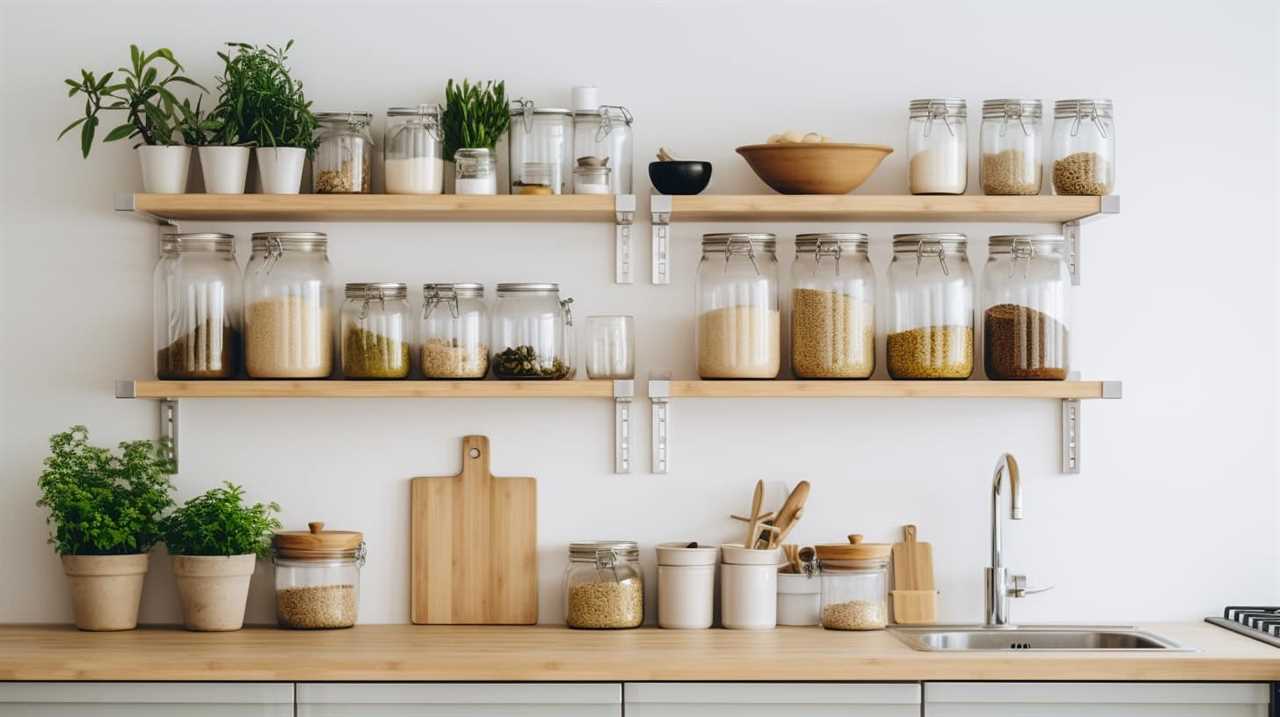Are you prepared to have a positive influence on the environment and streamline your life? We have you covered with our top 10 best methods for adopting a minimalist and eco-friendly lifestyle.
Did you know that embracing minimalism can reduce stress levels by 40%? By simplifying our living spaces, wardrobes, and daily routines, we can create a more sustainable and fulfilling life.
Join us as we explore practical tips to incorporate eco-friendly practices, support local businesses, and cultivate mindfulness in our everyday lives.
Let’s make a difference together!

Key Takeaways
- Embrace minimalism in your living space and wardrobe through decluttering, minimalist decor, and a capsule wardrobe
- Adopt a zero-waste lifestyle by using sustainable and reusable alternatives, practicing zero waste grocery shopping, and composting organic waste at home
- Utilize sustainable transportation options and incorporate eco-friendly practices in daily routines
- Choose sustainable and ethically sourced food options and support local businesses while conserving energy in your home
Simplifying Your Living Space
We can start simplifying our living space by decluttering our belongings. Simplifying our living space isn’t only aesthetically pleasing, but it also helps create a calm and peaceful environment.
One way to achieve this is by incorporating minimalist decor into our homes. Minimalist decor focuses on clean lines, simplicity, and functionality. By choosing furniture and accessories that serve a purpose and eliminate excess, we can create a more organized and efficient living space.
Another effective technique for simplifying our living space is by implementing organizing techniques. This can include using storage containers, labeling items, and creating designated spaces for different belongings.
Embracing Minimalism in Your Wardrobe
When it comes to embracing minimalism in your wardrobe, there are a few key points to consider.

First, a capsule wardrobe offers numerous benefits, such as saving time and money, and reducing decision fatigue.
Second, making sustainable fashion choices is essential for minimizing the environmental impact of our clothing.
Capsule Wardrobe Benefits
With a capsule wardrobe, we can simplify our clothing choices and reduce our environmental impact by embracing a minimalist approach to our wardrobes. Here are the benefits of adopting a capsule wardrobe:
-
Versatility: A capsule wardrobe consists of a limited number of essential and versatile pieces that can be mixed and matched to create multiple outfits. This allows for endless outfit possibilities without the need for a large wardrobe.

-
Time and money savings: By investing in high-quality, versatile pieces that can be worn in different ways, we eliminate the need for constant shopping and impulse purchases. This saves both time and money in the long run.
-
Reduced environmental impact: By owning fewer clothes and buying less, we contribute to reducing the demand for fast fashion and its negative impact on the environment. A capsule wardrobe promotes mindful consumption and sustainability.
Embracing a capsule wardrobe brings numerous benefits, including versatility, time and money savings, and a reduced environmental impact. It’s a practical and sustainable approach to dressing that can simplify our lives while still allowing us to express our personal style.
Sustainable Fashion Choices
By choosing sustainable fashion options and embracing minimalism in our wardrobes, we can actively contribute to a more eco-friendly and conscious lifestyle. Sustainable fashion choices aren’t only better for the environment, but they also promote ethical practices and support fair trade.

When building an eco-friendly wardrobe, it’s important to consider the materials used in clothing production. Opt for natural fibers like organic cotton, hemp, and bamboo, which are renewable and biodegradable. Look for clothing brands that prioritize sustainability and transparency in their supply chain.
Additionally, embracing minimalism in our wardrobes means buying fewer items and focusing on versatile pieces that can be mixed and matched. This reduces waste and promotes a more sustainable approach to fashion.
Decluttering for Minimalist Wardrobe
We often find that decluttering our wardrobes is a key step in embracing a minimalist lifestyle. Not only does it help us create a more organized space, but it also allows us to focus on the items that truly bring us joy and reflect our personal style.
When it comes to minimalist organization, here are three tips to help you declutter your wardrobe and embrace a more sustainable fashion trend:

-
Assess your wardrobe: Take the time to go through each item in your wardrobe and ask yourself if it serves a purpose or brings you joy. If not, it’s time to let it go.
-
Invest in quality pieces: Instead of buying into fast fashion trends, opt for high-quality, timeless pieces that will last longer and reduce the need for constant wardrobe updates.
-
Practice mindful shopping: Before making a purchase, consider if it aligns with your values and if you truly need it. This will help you avoid unnecessary clutter and contribute to a more sustainable fashion industry.
Adopting a Zero-Waste Lifestyle
Let’s start our journey towards a zero-waste lifestyle by embracing sustainable and reusable alternatives. To truly reduce our waste, we need to focus on two key areas: zero waste grocery shopping and composting at home. By making small changes in our shopping habits and diverting organic waste from landfills, we can make a significant impact on the environment.

When it comes to zero waste grocery shopping, it’s all about being mindful of our choices. Opt for package-free products or bring your own reusable bags, jars, and containers to store items like grains, nuts, and produce. This not only reduces packaging waste but also encourages us to buy only what we need, reducing food waste.
Composting at home is another effective way to minimize waste. By converting organic waste like fruit and vegetable scraps, coffee grounds, and eggshells into nutrient-rich compost, we can nourish our plants and garden while keeping waste out of landfills. Not only does it reduce methane emissions, but it also helps us contribute to a circular economy.
In summary, adopting a zero-waste lifestyle requires a conscious effort to shop sustainably and compost at home. By making these simple changes, we can significantly reduce our environmental footprint and create a healthier, more sustainable future.
| Zero Waste Grocery Shopping | Composting at Home | Benefits |
|---|---|---|
| Choose package-free products or bring reusable bags, jars, and containers | Convert organic waste into nutrient-rich compost | Reduces packaging waste and food waste |
| Buy only what you need to minimize food waste | Nourishes plants and gardens | Reduces methane emissions |
| Support local farmers and producers to reduce transportation-related emissions | Contributes to a circular economy | Creates a healthier, more sustainable future |
Utilizing Sustainable Transportation Options
When considering our daily commute and travel plans, let’s explore sustainable transportation options that minimize our carbon footprint. By choosing eco-friendly modes of transportation, we can contribute to a cleaner and greener future.

Here are three practical ways to incorporate sustainable transportation into our lives:
-
Bike sharing: Take advantage of bike sharing programs available in many cities. Not only does cycling reduce emissions, but it also promotes a healthy lifestyle.
-
Public transportation: Opting for buses, trams, or trains reduces the number of cars on the road, leading to decreased air pollution. Plus, using public transportation allows us to relax or be productive during our daily commute.
-
Carpooling: Share rides with friends, neighbors, or colleagues to reduce the number of vehicles on the road. Carpooling not only lowers emissions but also saves money on fuel and parking fees.

By embracing these sustainable transportation options, we can make a positive impact on the environment while enjoying the convenience and benefits they offer.
Let’s choose a greener way to commute and travel!
Incorporating Eco-Friendly Practices in Your Daily Routines
By reducing waste and recycling, we can actively contribute to a more sustainable and eco-friendly lifestyle. But there are other daily routines we can incorporate to further our efforts.
One way is by using eco-friendly beauty products. These products are made with natural and organic ingredients, free from harmful chemicals and toxins. By choosing these products, we not only reduce our exposure to harmful substances, but also support companies that prioritize sustainability and ethical practices.

Another important practice is reducing water consumption. We can start by turning off the faucet while brushing our teeth, taking shorter showers, and fixing any leaks. Conserving water helps protect this precious resource and reduce our environmental impact.
Now, let’s move on to the next section and explore the importance of choosing sustainable and ethically sourced food options.
Choosing Sustainable and Ethically Sourced Food Options
As we strive to live a minimalist and eco-friendly lifestyle, it’s important for us to prioritize choosing sustainable and ethically sourced food options. By making conscious decisions about the food we consume, we can have a positive impact on the environment and support ethical farming practices.
Here are three ways to incorporate sustainable and ethically sourced food options into our daily lives:

-
Choose locally grown and seasonal produce: Opting for fruits and vegetables that are in season not only ensures freshness and flavor but also reduces the carbon footprint associated with long-distance transportation.
-
Support organic and regenerative farming: Look for labels such as ‘certified organic’ or ‘regeneratively grown’ when buying food. These farming practices prioritize soil health, biodiversity, and use of natural resources.
-
Buy from sustainable seafood sources: When it comes to seafood, choose options that are sustainably and responsibly harvested. Look for labels like MSC (Marine Stewardship Council) or ASC (Aquaculture Stewardship Council) to ensure you’re making ethical choices.
Making these small changes in our food choices can have a big impact on our environment and support the well-being of farmers and producers. Let’s embrace ethical farming and seasonal eating for a healthier and more sustainable future.

Implementing Energy-Saving Techniques in Your Home
Let’s talk about how we can make our homes more energy-efficient.
One way is by using efficient lighting options, such as LED bulbs, which consume less energy and last longer.
Another technique is installing a smart thermostat, which allows us to control the temperature and save energy when we’re not at home.
Lastly, adding insulation to our homes can help conserve energy by keeping the indoor temperature stable.

Let’s implement these energy-saving techniques and make our homes more eco-friendly.
Efficient Lighting Options
We can maximize energy efficiency in our homes by utilizing efficient lighting options. Here are some ways to achieve this:
-
Switch to LED lighting options: LED bulbs use significantly less energy than traditional incandescent bulbs, making them a more sustainable choice for your home.
-
Utilize natural light: Make the most of natural light by keeping curtains open during the day and strategically placing mirrors to reflect light into darker areas. This will reduce the need for artificial lighting during daylight hours.

-
Install dimmer switches: Dimmer switches allow you to adjust the brightness of your lights according to your needs, saving energy when full brightness isn’t required.
By embracing these efficient lighting options, we can reduce our energy consumption and contribute to a more sustainable future.
Now, let’s explore the benefits of implementing smart thermostats in our homes.
Smart Thermostat Benefits
To truly optimize energy usage and reduce our environmental impact, we should consider the benefits of implementing smart thermostats in our homes.

Smart thermostat installation is a simple yet effective way to save energy and lower our utility bills. These devices allow us to control the temperature of our homes remotely, ensuring that we only use energy when needed. They also offer features like programmable schedules, which can automatically adjust the temperature based on our daily routines.
By using a smart thermostat, we can easily follow energy saving tips for home, such as setting higher temperatures during the summer or lower temperatures during the winter when we aren’t at home. This not only helps us save money but also reduces our carbon footprint.
Now, let’s explore another technique for energy conservation: insulation.
Insulation for Energy Conservation
And if we want to further reduce our energy consumption and create a more eco-friendly home, insulation is a key technique we should consider. Proper insulation can help us save energy and money by keeping our homes warm in winter and cool in summer.

Here are three reasons why insulation is essential for energy-efficient homes:
-
Energy Savings: Insulation materials such as fiberglass, cellulose, and foam can significantly reduce heat transfer, preventing the need for excessive heating or cooling. This leads to lower energy consumption and reduced utility bills.
-
Comfortable Living: Insulation creates a barrier against outdoor temperature fluctuations, making our homes more comfortable year-round. It helps maintain a consistent indoor temperature and reduces drafts and cold spots.
-
Environmental Impact: By reducing our energy consumption, insulation contributes to a greener and more sustainable lifestyle. It helps reduce greenhouse gas emissions and our carbon footprint.

Considering these benefits, investing in proper insulation is a practical and effective way to create an energy-efficient and eco-friendly home.
Supporting Local and Eco-Conscious Businesses
By shopping at local and eco-conscious businesses, we can contribute to a more sustainable and community-oriented economy. Supporting local farmers helps to reduce the carbon footprint associated with long-distance transportation of goods and also ensures the freshness and quality of the produce we consume. Additionally, choosing eco-friendly product alternatives reduces our reliance on harmful chemicals and materials that can harm both our health and the environment.
Here is a table showcasing some ways we can support local and eco-conscious businesses:
| Ways to Support | Examples |
|---|---|
| Shop at farmers markets | Purchase locally grown fruits and vegetables |
| Buy from eco-friendly stores | Choose products made from recycled materials |
| Support small businesses | Purchase handmade or locally produced items |
| Use community-supported agriculture (CSA) | Sign up for a CSA program to receive fresh produce directly from local farms |
Emphasizing Quality Over Quantity in Your Purchasing Decisions
When it comes to our purchasing decisions, it’s important to prioritize quality over quantity.

By being mindful consumers, we can make sustainable buying habits that have a positive impact on the environment.
Conscious consumption means considering the long-term effects of our choices and investing in products that are built to last, reducing waste and promoting a minimalist lifestyle.
Mindful Consumer Choices
As we strive for a more minimalist and eco-friendly lifestyle, it’s crucial to make mindful consumer choices. One way to do this is by emphasizing quality over quantity in our purchasing decisions. By practicing ethical consumerism and opting for sustainable product alternatives, we can make a positive impact on both our own well-being and the environment.
Here are three key ways to make mindful consumer choices:

-
Research and Support Ethical Brands: Look for companies that prioritize sustainable practices, fair trade, and ethical sourcing. By supporting these brands, we can encourage others to follow suit and create a more sustainable market.
-
Invest in Durable and Long-lasting Products: Instead of buying cheap and disposable items, opt for high-quality products that are built to last. This not only reduces waste but also saves money in the long run.
-
Consider Second-hand and Repurposed Goods: Before purchasing something new, explore second-hand options and repurposed items. This not only reduces the demand for new products but also gives new life to pre-loved items.
Sustainable Buying Habits
Our sustainable buying habits should prioritize quality over quantity in our purchasing decisions. By focusing on quality, we can ensure that the products we buy are long-lasting, reducing the need for frequent replacements and ultimately reducing waste. This approach applies to various areas of our lives, including sustainable grocery shopping and eco-friendly home decor.

When it comes to sustainable grocery shopping, we can choose products that are locally sourced and organic, supporting local farmers and reducing the carbon footprint associated with long-distance transportation. Opting for products with minimal packaging or packaging made from recycled materials is another way to reduce waste.
In terms of eco-friendly home decor, investing in high-quality, durable pieces made from sustainable materials such as bamboo or reclaimed wood can significantly reduce our impact on the environment. Additionally, choosing energy-efficient appliances and opting for natural cleaning products can further contribute to an eco-friendly home.
By prioritizing quality over quantity in our purchasing decisions, we can make a positive impact on the environment while also enjoying products that are built to last.
Transitioning into the subsequent section about the ‘impact of conscious consumption’, let’s explore how our buying habits can influence the world around us.

Impact of Conscious Consumption
But, by emphasizing quality over quantity in our purchasing decisions, we can make a significant impact on the environment and our overall lifestyle. Conscious shopping is all about being mindful of the products we buy and their impact on the world. Here are three reasons why prioritizing quality over quantity is essential:
-
Reduced waste: When we choose high-quality, durable items, they last longer and reduce the amount of waste we generate. Instead of buying cheap products that break easily and end up in landfills, we can invest in items that will stand the test of time.
-
Ethical production: By opting for products that are ethically produced, we can support companies that prioritize fair labor practices and sustainable sourcing. This ensures that workers are treated fairly and that the production process doesn’t harm the environment.
-
Cost-effectiveness: Although quality products may initially seem more expensive, they often provide better value in the long run. Investing in durable items saves money on replacements and repairs, making it a financially savvy choice.

Practicing Mindfulness and Gratitude in Your Everyday Life
Let’s incorporate a daily gratitude practice into our lives to cultivate mindfulness and appreciate the little things. Practicing mindfulness and gratitude can have a profound impact on our overall well-being and help us live a more fulfilling and eco-friendly lifestyle.
One way to incorporate mindfulness into our daily routine is through mindful eating. By paying attention to the colors, textures, and flavors of our food, we can fully enjoy and savor each bite. This not only helps us to be more present in the moment, but it also encourages us to make healthier and more conscious food choices.
Another way to cultivate gratitude is through journaling. Taking a few minutes each day to write down the things we’re grateful for can shift our focus towards the positive aspects of our lives and help us appreciate the abundance around us.
Frequently Asked Questions
How Can I Incorporate Eco-Friendly Practices Into My Daily Routines?
We can incorporate eco-friendly practices into our daily routines by using green cleaning products and implementing tips for reducing food waste. These small changes make a big impact on the environment and help create a more sustainable lifestyle.

What Are Some Sustainable Transportation Options I Can Use?
Looking for sustainable transportation options? Bicycles and electric scooters are great for short distances, while public transportation and carpooling reduce emissions and save money. Let’s explore these eco-friendly choices together!
How Can I Simplify My Living Space?
To simplify our living space, we can start by decluttering and utilizing minimalist home decor. This will create a calm and organized environment, allowing us to focus on what truly matters and reducing our carbon footprint.
What Are Some Energy-Saving Techniques I Can Implement in My Home?
We can save energy in our homes by implementing solar panel installation and smart home automation. These techniques not only reduce our carbon footprint but also help us save money on electricity bills.
How Can I Support Local and Eco-Conscious Businesses?
Looking to support local and eco-conscious businesses? We’ve got you covered! Discover how to find them and show your financial support. Let’s make a difference together and create a sustainable future.

Conclusion
In conclusion, by simplifying our living spaces, embracing minimalism in our wardrobes, and adopting a zero-waste lifestyle, we can create a minimalist and eco-friendly lifestyle.
Additionally, by utilizing sustainable transportation options, incorporating eco-friendly practices, and implementing energy-saving techniques, we can further reduce our environmental impact.
Moreover, supporting local and eco-conscious businesses, emphasizing quality over quantity, and practicing mindfulness and gratitude can contribute to a more sustainable future.
Let’s choose to make small changes today that will have a big impact on our planet tomorrow.

Together, we can build a better and more sustainable future.
I’m Theodore, and I love tiny houses. In fact, I’m the author of Tiny House 43, a book about tiny houses that are also tree houses. I think they’re magical places where imaginations can run wild and adventures are just waiting to happen.
While tree houses are often associated with childhood, they can be the perfect adult retreat. They offer a cozy space to relax and unwind, surrounded by nature. And since they’re typically built on stilts or raised platforms, they offer stunning views that traditional homes simply can’t match.
If you’re looking for a unique and romantic getaway, a tree house tiny house might just be the perfect option.










